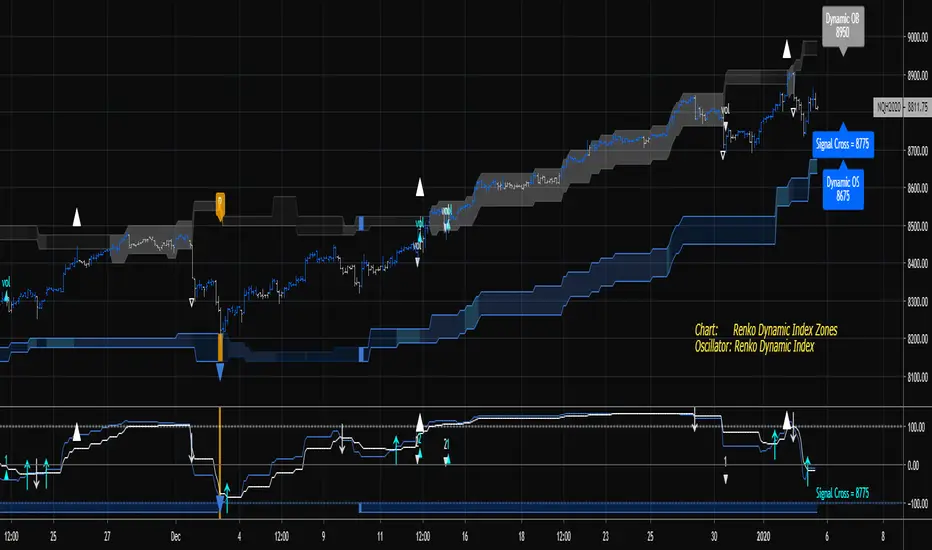INVITE-ONLY SCRIPT
已更新 Renko Dynamic Index

The goal of this indicator is to plot the Dynamic Index, Signal, and Histogram values "as if" the chart is a true price action based Renko chart. It can be used on a time series chart or Renko series chart. The Dynamic Index is derived from the raw price action of a time-based chart, where the historic and live price values are clustered into Renko bricks. The Renko brick production algorithm is entirely backed by Renko Overlay Ribbon and thoroughly tested. The Dynamic Index gets its inspiration from the Commodity Channel Index.
The algorithm takes into account rapid brick production within a single time candle and adjusts accordingly. The output may vary slightly between different chart time frames for the same indicator settings, but this is due to the lack of price fluctuation visibility that can occur in higher chart time frames. If the brick tick size is low, an appropriate chart interval should be selected that maximizes the amount of price volatility visible to the indicator. A bad setting would be something like a 1 tick EURUSD Renko setting on an H4 or Day chart, there simply is no way to derive the exact and ordered price fluctuations in a single candle, 1 pip at a time. A more appropriate chart time frame would be 1-5 minutes for this selected Renko brick size.
Please find the following video introduction helpful for this indicator and the Renko Dynamic Index Zones indicator:

If you are interested in the RSI-RENKO DIVINE™ Strategy please have a look here:

Contact me in Trading View or telegram for more information and access instructions.
The algorithm takes into account rapid brick production within a single time candle and adjusts accordingly. The output may vary slightly between different chart time frames for the same indicator settings, but this is due to the lack of price fluctuation visibility that can occur in higher chart time frames. If the brick tick size is low, an appropriate chart interval should be selected that maximizes the amount of price volatility visible to the indicator. A bad setting would be something like a 1 tick EURUSD Renko setting on an H4 or Day chart, there simply is no way to derive the exact and ordered price fluctuations in a single candle, 1 pip at a time. A more appropriate chart time frame would be 1-5 minutes for this selected Renko brick size.
Please find the following video introduction helpful for this indicator and the Renko Dynamic Index Zones indicator:

If you are interested in the RSI-RENKO DIVINE™ Strategy please have a look here:

Contact me in Trading View or telegram for more information and access instructions.
版本注释
- Added trend change recognition algorithms. These can be toggled on/off by the check box "Show Trend Changes".
版本注释
- Slight tweak to the trend change and trend direction algorithm.
版本注释
- Fixed bug in trend direction algorithm.
版本注释
- Updating trend change color fills matching the Dynamic Index Zones. You will see visuals now representing the trend algorithm that correlate to the Renko Zones script.
版本注释
- Updated member features.
免责声明
这些信息和出版物并不意味着也不构成TradingView提供或认可的金融、投资、交易或其它类型的建议或背书。请在使用条款阅读更多信息。

